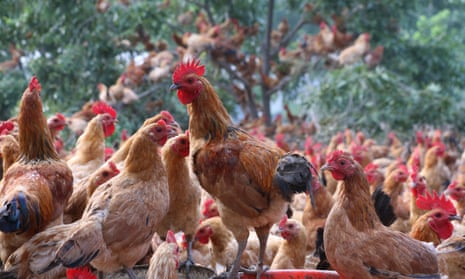On my puzzle blog earlier today I set these four questions, here restated with the answers:
1. If cocks cost 5 qian each, hens cost 3 qian each and chicks are three for a qian, how many cocks, hens and chicks do I buy if I buy 100 of them altogether for exactly 100 qian.
Solution. We solve this problem by turning the question into two equations. (When the question was set in ancient China they were not able to do this since this technique had not yet been invented. And perhaps this is why there are, in fact, four solutions.)
If the number of cocks, hens and chicks are x, y and z. Then we have
(A) x + y + z = 100
(B) 5x + 3y + z/3 = 100
Multiply (B) by 3 to get (C) 15x + 9y + z = 300. From (A) we know that z = 100 – x – y. Substitute that expression for the z in (C) and we get an equation that simplifies to 14x + 8y = 200. We can assume from the question that since we are dealing in animals, we cannot buy fractions of animals. In other words we are looking for whole number solutions, and the only way to find them is trial and error. There are four solutions
- x = 0 and y = 25, in which case z = 75
- x = 4 and y = 18, in which case z = 78
- x = 8 and y = 11, in which case z = 81
- x = 12 and y = 4, in which case z = 84
The answer is that you would buy either zero cocks, 25 hens and 75 chicks, OR 4 cocks, 18 hens and 78 chicks, OR 8 cocks, 14 hens and 78 chicks, OR 12 cocks, 4 hens and 84 chicks.
NOTE: There was originally a typo above (as noticed by several readers in the comments). This has now been changed. Also, in response to the comments below, there are other ways to find the results than by trial and error, but these rely on some technical maths, such as remembering an algorithm, which is beyond the general reader.
2. If a hen and a half lays an egg and a half in a day and a half, how many eggs do half a dozen hens lay in half a dozen days?
Solution 24 eggs
Assuming all hens behave similarly, and egg laying proceeds in linear way, we can state that 1.5 hens lay 1.5 eggs in 1.5 days.
Four times the number of hens gives four times the number of eggs in the same time interval, i.e 6 hens lay 6 eggs in 1.5 days.
In a time interval four times longer, the same number of hens will produce four times the number of eggs, so 6 hens lay 24 eggs in 6 days.
3. What is 2/7 chicken, 2/12 Essex warbler and 3/8 terrapin?
Solution. CHESTER!
CHicken + ESsex warbler + TERrapin
(The original question that asks what is 3/7 chicken, 2/3 cat and 2/4 goat is CHICAGO)
4. The chicken was twice as old when when the day before yesterday was to-morrow to‑day was as far from Sunday as to-day will be when the day after to-morrow is yesterday as it was when when to-morrow will be to-day when the day before yesterday is to-morrow yesterday will be as far from Thursday as yesterday was when to-morrow was to-day when the day after to-morrow was yesterday.
On what day was the chicken hatched out?
Solution. Friday.
The opening sentence is saying: “The chicken was twice as old on X as it was on Y”, where both X and Y refer to days and where:
X is “when the day before yesterday was to-morrow to‑day was as far from Sunday as to-day will be when the day after to-morrow is yesterday”
Y is “when to-morrow will be to-day when the day before yesterday is to-morrow yesterday will be as far from Thursday as yesterday was when to-morrow was to-day when the day after to-morrow was yesterday”
Let’s first divide X into sections.
(A) when the day before yesterday was to-morrow
(B) to‑day was as far from Sunday as to-day will be
(C) when the day after to-morrow is yesterday
We can translate this:
(A) when two days before this day is one day from now. In other words, in three days time.
(B) is saying that (A) and (C) are equidistant from Sunday
(C) when a day ago was in two days’ time. In other words, three days ago.
So, the section states that the day in question is when the day three days before and three days after that day are equidistant from Sunday. If this is the case, the day must be Sunday. So X is a Sunday. Now let’s do the same with Y.
(A) when to-morrow will be to-day
(B) when the day before yesterday is to-morrow
(C) yesterday will be as far from Thursday as yesterday was
(D) when to-morrow was to-day
(E) when the day after to-morrow was yesterday
We can translate this:
(A) when the day after this day is today, in other words, one day ago.
(B) when two days ago is a day from now, in other words, in three days time.
(C) we can rephrase this as ‘today will be as far from Friday as today was’, in other words, (A) and (B) are as far from Friday as (D) and (E).
(D) when the day after this day was today, in other words, one day ago.
(E) when two days after this day was a day ago, in other words, three days ago.
If (A) is one day ago (–1) and (B) is in three days time (+ 3), when we combine (A) and (B) we get an outcome of –1 + 3 = + 2, or in two days time. Likewise we combine (D) and (E), or one day ago (–1) and three days ago (–3), to get –4, or four days ago. So, the section is determining that the day Y in question is when two days after that day (Y + 2) and four days before that day (Y – 4) are equidistant from Friday. Since these two days are six days apart, Y+ 2 must be three days from Friday, and Y – 4 must be three days from Friday. So Y must be the day after Friday. Y is Saturday.
The statement in the question is therefore saying that the chicken was twice as old on Sunday as it was on Saturday. Therefore the chicken hatched out on Friday.
****
For those of you who managed to get this far, the reason why my new book Football School Season 2 features a hapless chicken in a Brazil kit is because the word frango, or chicken in Portuguese, means a goal scored as a result of an embarrassing goalkeeping error.
I set a puzzle here every two weeks on a Monday. Send me your email if you want me to alert you each time I post a new one. I’m always on the look-out for great puzzles. If you would like to suggest one, email me.

My latest book is Football School Season 2, the follow-up to Football School, a book series aimed at 7-12-year-olds which TalkSPORT called “a Horrible Histories for football.” The new book explains why every stadium has a vomitory, the physics of why footballs are NOT round and which international goalkeeper used to pee on the pitch before penalty shoot-outs. As well as lots of maths, English, history, geography, modern languages and more. The perfect gift for a football-mad boy or girl! Info, activity sheets and more at footballschool.co.

Comments (…)
Sign in or create your Guardian account to join the discussion